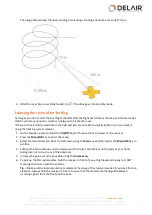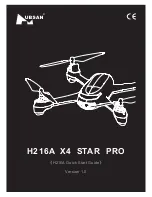
l
the aircraft is missing or completely inaccessible
Note –
A landing on the intended landing site that causes damage to the aircraft due to the landing
surface cannot be seen as a crash.
1. If a crash occurs which causes injuries or death, you must:
a. Contact the emergency services.
b. Help where necessary, without risking your own life.
c. Make a perimeter around the accident. Make sure no evidence disappears.
d. Notify your civil aviation authority (CAA).
2. If a crash occurs which causes damage to another object:
a. Contact the emergency services when necessary (for example, if gas, electricity, or water supplies
are affected).
b. Contact the owners of the object that is hit.
c. Notify your civil aviation authority.
3. Take pictures of the crash site. Download the data files from the GCS and send all data and pictures to
your Delair distributor.
Landing the rover
WARNING –
Make sure there are no people or obstacles near the landing zone. Failure to do so could
result in serious personal injury and damage to the rover.
CAUTION –
It is your responsibility to ensure the safety of the rover during landing. To do this you
must:
l
Have visual contact with the rover at all times.
l
Observe the zone of operation for the rover and look out for other aerial objects.
l
Ensure obstacle clearance.
l
Locate the rover on the tablet screen.
By default, the rover lands automatically.
After passing the last waypoint on the scan lines, the rover terminates its flight plan and initiates a normal
landing sequence. It flies at cruise height to the entry point which is located 300 m (984 ft) from the landing
location. It starts circling downward in 200 m (656 ft) diameter circles until it reaches a height of 75 m (246
ft). It keeps circling in left or right circles, depending on the direction specified in the Aerial Imaging
software, until you tap
in the message box on the map.
1. To complete the landing, tap
in the message box on the map.
The rover finishes its current circle until it reaches the intersection with the landing direction and then
it starts the final leg of the landing.
93
Delair-Tech
|
676, Rue Max Planck – 31670 Toulouse-Labège, France
|
Tel: +33 (0) 5 82 95 44 06
|
Capital: 238 110,30 € - APE: 3030Z – Intra-Community VAT number: FR90 53 09 69 781 – 530 969 781 R.C.S. Toulouse
This document is the sole property of Delair-Tech and cannot be used or reproduced without the written authorization of Delair-Tech
.










































